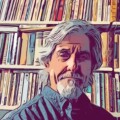News & Articles
Browse all content by date.



Tonya Borgeson, an instructor at Lake Superior College, has been making ceramics for nearly two decades. Based on her numerous shows, workshops, and activities, she appears to have an indefatigable energy. She is especially passionate about Lake Superior and hopes we will all think deeply about the big lake’s importance on Lake Superior Day, July 15. You can also visit her current show at the Whole Foods Co-op through August 7.
EN: What prompted you to take an interest in ceramics as a means of expression?
TB: My mom grew up in Wrenshall, and there was a lot of natural clay there. We used to play with that clay. When I took art in school, Mr. Pullan the art teacher was a ceramicist and he encouraged us to try the wheel. I know of several other ceramic artists from my high school.
So I applied for colleges and decided to go into graphic design or interior design. But I started doing ceramics in seventh grade, and by the time I was a junior and senior I was helping teach in Mr. Pullan’s art classes. I was literally taken out of classes—math, science, English—to make posters for teachers. I was highlighted for my creativity in my high school.
I fell into choosing ceramics in college because I felt so comfortable in the pottery room. So I took the pottery class and the teacher Roy Strassburg pulled me aside and asked how I developed my skill. He suggested I become a ceramics artist, which I never had heard of before, that a person could be just a ceramics artist.
After that I switched my major to a bachelor of fine arts with a specialty in ceramics and painting.
EN: You got your MFA at Indiana State U. What were some of the things you learned through that experience?
TB: First I did a student-at-large position at Carbondale, IL, which was an experience-builder and resume-builder. You also continue to expand your web of people whom you become colleagues with. I was there for two terms and then moved to Indiana State University.
I learned independent thinking, and strong evaluation of your projects and concepts. During that time I had multiple art history classes and was interested in artists who were untrained, artists like Jean Dubuffet, folk artists, and tribal and ceremonial art. At the time I felt like I was aligning myself with artists who documented our human time.
It was while working on my masters that I became involved in community-based art, or art that was placed in the community, with natural materials. I did a twenty-acre land drawing outside Chicago, using the earth as a medium, and that no one could see except in a plane.
Through that research I developed the concept of this Snoodle, a community clay center. I had a whole section on how to start a community art center, not knowing that I would come up to Duluth and end up doing that. I visited other centers and researched and wrote about it in my masters thesis.
EN: So what is the Snoodle?
TB: The Snoodle is my working studio space as well as a community clay center. Anybody from age 2 to 102 can come in and within one hour can make something. I offer hands-on events and teach techniques. There is also a gallery space where we show art by various artists in different mediums. People can come and rent space here, rent the kilns, use the tools.
EN: You currently have a solo exhibition about water at the Whole Foods Co-op. How did you become such an advocate for water?
TB: It developed out of my own growth as an artist. As an undergrad I concentrated on our humanity and spirituality of place. In graduate school I felt like my work represented animal, human, and earth elements. So then I just kept working through that, continually building upon them and becoming more and more aware of what you are seeing in the work. All of a sudden, at a certain point it switched to water. Along with these other art forms I also sketch daily. The drawings began to show a cloud theme and the influence of water… and reading about it in the media that people are dying because they don’t have access to water and hearing people in our region saying there is not a water issue, which was so shocking to me because we are in a huge water issue worldwide. Like any valuable resource, there is a potential end to that resource.
Why am I doing this over and over again? Memory is selective. Impressions that stick to the mind today start to lose their tint over time. What will people remember one year, two years, ten years from now? I’m continually trying to raise awareness about the present global state as well as local situations. By bringing the problem to light, I want people to find ways to find intelligent, trend-setting solutions. Don’t forget that infinite inner resource: our imagination.
| Tweet |


